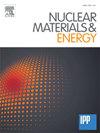Heat and particle exhaust in double-null configuration in WEST: Experimental study and modeling with SOLEDGE-EIRENE
IF 2.7
2区 物理与天体物理
Q1 NUCLEAR SCIENCE & TECHNOLOGY
引用次数: 0
Abstract
The WEST tokamak allows for high power steady-state plasma discharges in Lower Single-Null (LSN), Double-Null (DN) and Upper Single-Null (USN) configurations. In this contribution, first results from experimental L-mode DN discharges with 3.1 MW of additional heating in the WEST tokamak and associated modeling with the SOLEDGE-EIRENE code are presented. The goal is to investigate if the magnetic configuration could help to reduce the peak heat load on the targets, and how sensitive is the power sharing between the strike points to a change in magnetic equilibrium. This study, previously performed on other devices such as DIII-D, Alcator C-mod and MAST-U, provide new data for machines with a compact divertor configuration and tungsten walls. During the experiment, the distance between the two separatrices at the outer midplane dRsep was scanned from –32 mm (USN) to 42 mm (LSN), with the ion Bx∇B drift directed towards the lower divertor. The measured power fall off length mapped at the outer midplane can vary between configurations but is centered around λq = 15.6 ± 2.4 mm. In the DN configuration, Langmuir probes measurements have shown that 86 % of the power is directed towards the outer strike points. This inner/outer imbalance is consistent with the ones measured on DIII-D, Alcator C-mod and MAST-U. The influence of ballooned radial transport, that drives most of the power towards the low field side, has been reproduced in transport simulation with imposed poloidally ballooned cross-field transport. The peak heat flux measured on all strike points is reduced by half in DN compared to LSN configuration. In certain conditions of high radiations (Ohmic discharges or with ICRH), the DN configuration can trigger a MARFE on the High-Field Side (HFS) that moves in opposition to the oscillations of the plasma vertical position. This MARFE has been measured to account for 0.3 % of the particles in the plasma. Temperature and density of the core plasma are unaffected by its presence.
西部双零态热与粒子排气:SOLEDGE-EIRENE的实验研究与模拟
WEST托卡马克允许在低单空(LSN),双空(DN)和上单空(USN)配置下进行高功率稳态等离子体放电。本文首先介绍了在WEST托卡马克中使用3.1 MW额外加热的l模DN放电实验结果,并使用SOLEDGE-EIRENE规范进行了相关建模。目的是研究磁性配置是否有助于减少目标的峰值热负荷,以及打击点之间的功率共享对磁性平衡变化的敏感性。之前在DIII-D、Alcator C-mod和MAST-U等其他设备上进行的这项研究,为具有紧凑分流器配置和钨壁的机器提供了新的数据。在实验过程中,在dRsep的外中间面,两个分离体之间的距离从-32 mm (USN)扫描到42 mm (LSN),离子Bx∇B的漂移方向为下导流器。测量的功率衰减长度映射在外背板可以不同的配置,但中心在λq = 15.6±2.4 mm。在DN配置中,Langmuir探针的测量结果表明,86%的功率指向外部打击点。这种内外不平衡与DIII-D、alcater C-mod和MAST-U测量的结果一致。充气径向输运的影响,驱使大部分能量向低场侧移动,已经在输运模拟中与施加极性充气跨场输运重现。与LSN配置相比,DN中所有打击点上测量的峰值热通量减少了一半。在某些高辐射条件下(欧姆放电或ICRH), DN配置可以触发高场侧(HFS)的MARFE,其运动方向与等离子体垂直位置的振荡方向相反。据测量,该MARFE占等离子体中粒子的0.3%。核心等离子体的温度和密度不受其存在的影响。
本文章由计算机程序翻译,如有差异,请以英文原文为准。
求助全文
约1分钟内获得全文
求助全文
来源期刊

Nuclear Materials and Energy
Materials Science-Materials Science (miscellaneous)
CiteScore
3.70
自引率
15.40%
发文量
175
审稿时长
20 weeks
期刊介绍:
The open-access journal Nuclear Materials and Energy is devoted to the growing field of research for material application in the production of nuclear energy. Nuclear Materials and Energy publishes original research articles of up to 6 pages in length.
 求助内容:
求助内容: 应助结果提醒方式:
应助结果提醒方式:


